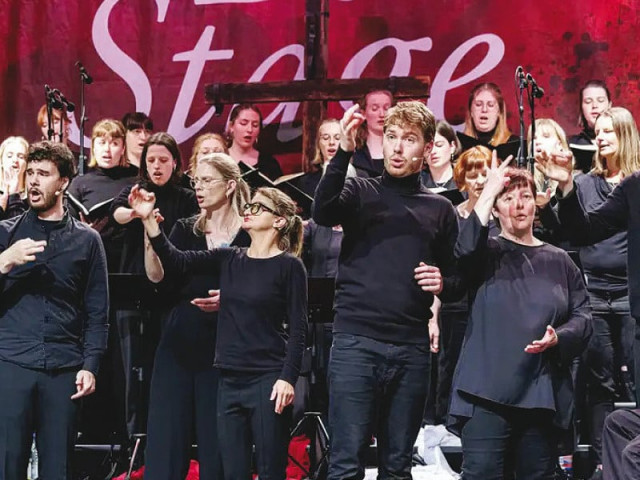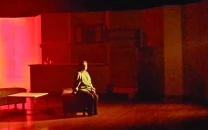Bach’s music — diverse and accessible
Composer’s cantatas not only inspire choirs worldwide, but also those who can’t hear his music

Eighty-eight people move on a large stage to the music of Johann Sebastian Bach. Some sing and reproduce the lyrics in sign language. The others perform a choreography of steps and gestures. They can barely hear the music, if at all, but what they pick up from the singers they translate into a visible art form for other hearing-impaired people.
This performance of Bach’s St. John Passion, the Passion of Christ according to the Biblical evangelist John, is an atmospheric experience for hearing and non-hearing people on Leipzig’s main square.
Soprano Susanne Haupt founded the inclusive singing ensemble Sing&Sign in 2017 for music enthusiasts with and without hearing impairments. She wants to enable hearing-impaired people to experience Bach’s cantatas, she tells DW.
Bach endured much suffering
Alongside Ludwig van Beethoven, the baroque composer Johann Sebastian Bach is one of the most famous and influential German composers of all time. In his honour, the Bach Festival is held annually in Leipzig, which runs from June 7 to 16 this year. For 27 years until his death in 1750, Bach was Leipzig’s municipal music director and Thomaskantor, i.e. director of the choir of the Protestant Thomaskirche in Leipzig.
For Susanne Haupt, he is not only a universal composer, but also someone who himself had to endure much suffering in his life. “Bach was already an orphan at the age of 10 and lost 10 of his 20 children. And he was blind for the last few months of his life,” she recalls. This is particularly evident in his poignant cantatas, says the singer and warns: “No one is guaranteed to remain unharmed until the end of their life.”
Bach’s choral cantatas
Every year, around 70,000 people from all over the world journey to Leipzig for the Bach Festival to hear Johann Sebastian Bach’s music where it was composed. This year, they have come from over 50 countries from all continents. Many of them can sing along to the arias and recitatives of the St. John Passion, which Bach composed in 1724, exactly 300 years ago.
In 1724/25, he also composed 50 so-called “choral cantatas,” which are the focus of this year’s Bach Festival. The recipe for these choral cantatas sounds simple. “Bach took a chorale and set each verse to music with different instrumentation and different melodies over the course of the piece,” explains Bachfest director Michael Maul.
Many of Bach’s choral texts were written by the Protestant church reformer Martin Luther, who published the first Protestant hymn book 500 years ago. He set stories from the Bible in catchy verses. “Many of these songs are no longer only found in the German Lutheran hymnals. They have even made it all over the world,” says Maul. For example, the chorale Now Thank We All Our God.
Also famous is the final chorale “It is enough” from Bach’s cantata O Eternity — Thou Word of Thunder, referring to when Jesus can no longer bear his agony on the cross and wants to be redeemed. Composer Alban Berg set this chorale to music in his violin concerto in 1935 and brought it into the 20th century. The Thomanerchor and the Gewandhaus Orchestra, conducted by the current Thomaskantor Andreas Reize, performed not only this cantata, but also the violin concerto, the solo violin played movingly by violinist Chouchane Siranossian.
Worldwide choirs provide diversity
This year, 30 international choirs have come especially to sing and celebrate Bach’s choral cantatas in 16 special concerts. The choirs hail not only from Germany, Europe and the USA, but also from Australia, Malaysia, Japan and Paraguay. “There are young people everywhere who are interested in Bach’s music,” says director Maul. The international choirs sing in German and bring music from their home countries with them.
The “Malaysia Bach Festival Singers and Orchestra” under the direction of David Chin will also be taking part. His entourage consists not just of members of the Christian community, but also Buddhists. It is not just Bach’s music, but also the message of his cantatas that brings people together, says David Chin: “It always goes from darkness to light; there is always a glimmer of hope.”
It is precisely this positive attitude that people need in view of the many wars and disasters, Chin tells DW. He too was initially afraid of Bach. “You see his portrait, a white man with a powdered wig who has nothing to do with Asia.” In fact, Bach looks grim in many portraits. “Then you start to learn his instrumental music and the relationship changes from fear to hatred,” says Chin, because the music is so difficult to play. “But then when you spend more time with his music and get to know his cantatas, you fall in love and there’s no going back.”


















COMMENTS
Comments are moderated and generally will be posted if they are on-topic and not abusive.
For more information, please see our Comments FAQ